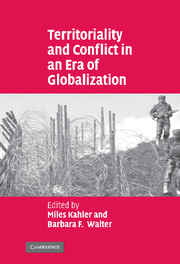Book contents
- Frontmatter
- Contents
- List of figures
- List of tables
- List of contributors
- Acknowledgments
- 1 Territoriality and conflict in an era of globalization
- Part I Territorial attachment and detachment
- Part II Territorial stakes and violent conflict
- Part III Territorial regimes in an era of globalization
- 9 The evolution of territoriality: international relations and American law
- 10 Trade and territorial conflict in Latin America: international borders as institutions
- Conclusion
- References
- Index
10 - Trade and territorial conflict in Latin America: international borders as institutions
Published online by Cambridge University Press: 22 September 2009
- Frontmatter
- Contents
- List of figures
- List of tables
- List of contributors
- Acknowledgments
- 1 Territoriality and conflict in an era of globalization
- Part I Territorial attachment and detachment
- Part II Territorial stakes and violent conflict
- Part III Territorial regimes in an era of globalization
- 9 The evolution of territoriality: international relations and American law
- 10 Trade and territorial conflict in Latin America: international borders as institutions
- Conclusion
- References
- Index
Summary
More than three decades ago, Richard Cooper stated that “the trend toward economic interdependence between countries will require substantial changes in their approach to foreign policy in the next decade or so” (1972, 159). A wide range of studies has since been premised on the proposition that interdependence has significantly raised the costs to governments and the economies they govern of taking unilateral action. One solution to problems of coordination and collaboration among states has been to develop international institutions that reduce transactions costs and uncertainty, allowing states to enjoy greater mutual gains than would have been possible in the absence of such institutions.
The institutional paradigm has informed a broad range of studies in international political economy (Simmons and Martin 2002). The same cannot be said of international conflict studies. Scholars looking at interstate disputes have typically bypassed institutional theory, focusing instead on the basic constellations of state power. The irony is that war and peace often revolve around the most ubiquitous international institution of the modern age: sovereign authority over delimited territorial space.
This chapter argues for a reconceptualization of international borders as they have come to be understood in the international relations literature. One branch of that literature has emphasized the extent to which disputes over territory, more than any other issue, have spurred interstate rivalry, military confrontation, and all-out war. Borders as territorial divisions are then analyzed as zero-sum manifestations of state competition for power, prestige, lebensraum, or an imagined historical identity.
- Type
- Chapter
- Information
- Territoriality and Conflict in an Era of Globalization , pp. 251 - 287Publisher: Cambridge University PressPrint publication year: 2006
- 10
- Cited by



